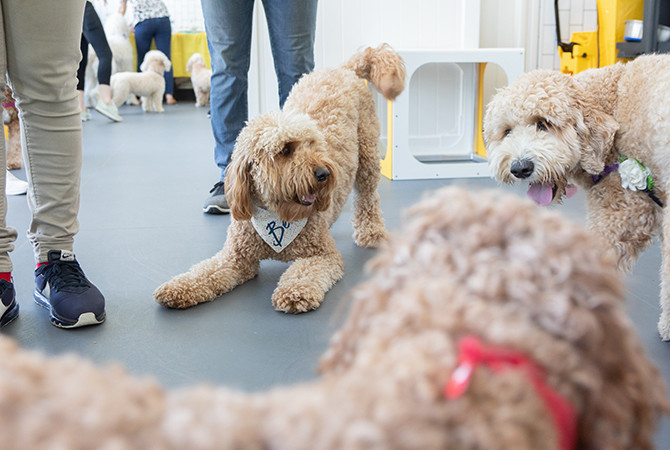Most dogs are social creatures, and it can become quite obvious when they encounter another dog while out for a walk. We’ve previously shared information on the important role social time plays in health and behavioral development for dogs, but what’s the best way to make chance encounters with other dogs a positive experience for everyone involved? Read on for our top tips on making polite and positive canine introductions.
Always Ask First
When you’re out and about on a walk with your pup, it’s inevitable that you will run into other dogs and their owners. That’s just part of city living. No matter how excited your dog is to greet the other dog, the number one rule of canine introductions is to ask the other owner if it’s okay to let the pups greet each other.
Some dogs may have shyness or aggression issues that make canine introductions tricky. Additionally, the owner of the other dog might be working on a training protocol or specific behaviors with their pup. Finally, they may simply be in a hurry and not have time for a proper greeting session. Asking first allows your fellow dog parent to make sure their dog is as excited and prepared for the introduction as your pup.
Pay Attention to the Signals
Dogs have their own language when communicating with each other, and some behaviors we may find rude or confusing are just part of normal dog-to-dog communication. For example, sniffing each other in private places, swatting with their paws, barking, and even some growls can be part of a perfectly fine interaction. These are all ways dogs learn about each other and communicate their boundaries.
However, there are particular signs you should be on the lookout for to help decipher if things are going well or if it’s time to break up the meeting. Play bows, wagging tails, and a relaxed posture in their bodies, faces and ears are all good signs. On the other hand, if one or both dogs is yawning, turning away from the interaction, hiding behind their owner, shaking, or has their hackles raised, then it’s time to say goodbye.
This raises another key to successful introductions: pay attention. Sometimes we get caught up chatting with the other human and lose our focus on the signals our pups are sending. Keep the interaction focused on the dogs. Once your dogs have had a few successful interactions and are comfortable with each other, then you can relax and enjoy catching up with the other owner. And don’t forget to praise and reward your dog during and after a positive interaction! (Just remember to get your fellow pet parent’s permission before offering treats to the other dog.)
If at First You Don’t Succeed…
It’s important to note that leashed greetings between dogs can be very different than off-leash interactions. Many dogs are much more tense during a leashed greeting, as they are very aware that their ability to escape the interaction is limited by their leash. An unsuccessful on-leash introduction doesn’t mean your dog is destined for a life of solitude. It might simply mean your dog needs some additional time and training to get comfortable with walking on-leash and encountering other dogs when on-leash.
Some dogs require a bit more time to get to know each other. If you encounter the same dog(s) repeatedly on walks and want to ensure they can become good neighbors, it’s a good idea to start slow. A short stop-and-sniff might be enough for the first intro. If that goes well, then maybe the next time you can lengthen the interaction—with the other owner’s permission and buy-in, of course!
It’s also a good idea to avoid stopping to meet every dog you encounter on a walk. While your pup might be a social butterfly, cultivating your dog-owner bond and giving your dog practice at focusing on you during walks is important. Not only will teaching them to focus on you help walks go faster (sometimes you really just want them to do their business so you can go about your day), but making sure your pup looks to you for approval helps curb behaviors like lunging, jumping, or pulling towards other dogs on walks. Those behaviors are not only unpleasant for you; they can also be triggering for other dogs with shyness or aggression issues.
You Can Teach an Old Dog New Manners
Your dog might have a history of poor interactions and failed introductions with other pups, but that doesn’t mean you have to give up on the idea of their having canine pals. For dogs with serious shyness or aggression issues that make leashed intros difficult, a professional trainer can make a world of difference. Working one-on-one with a trainer allows your dog to slowly build confidence and comfort in the process of meeting and greeting other pups. Plus, your trainer can teach you how to manage these interactions and give you a strategy for building your dog’s social skills.
Finally, if you have a brand-new puppy, we suggest enrolling in Puppy Kindergarten or other entry-level group obedience training. This environment provides structure for your puppy and support for you as a new pet parent. It also gets your pup comfortable meeting other dogs off- and on-leash, while helping them build their understanding of dog-to-dog communication and social cues.


